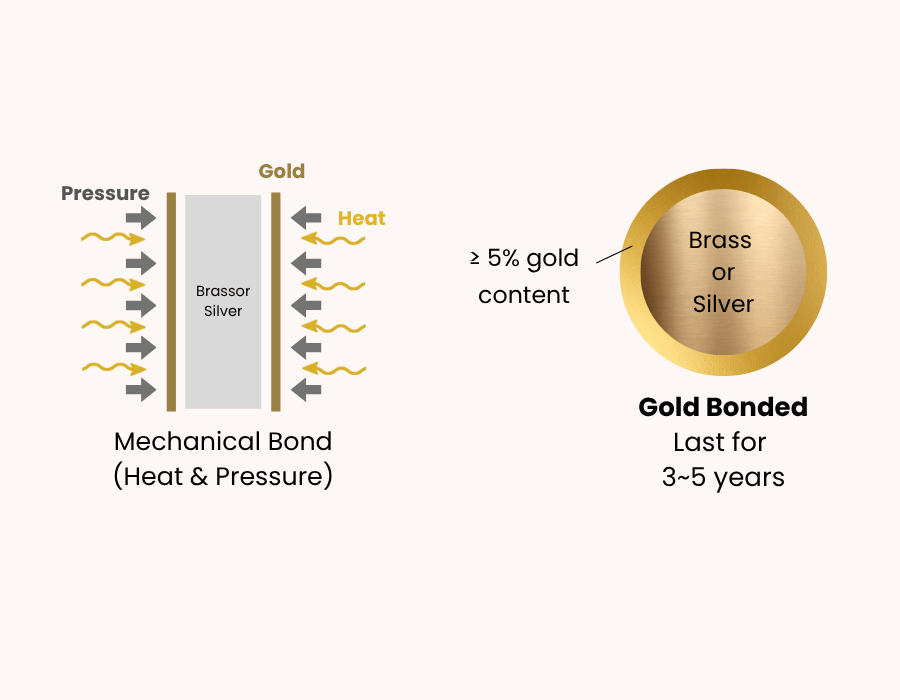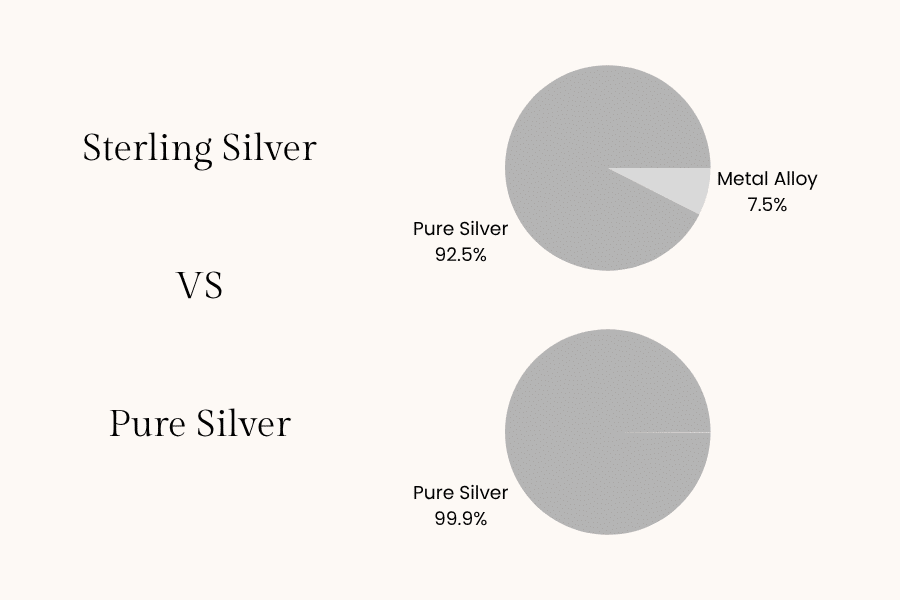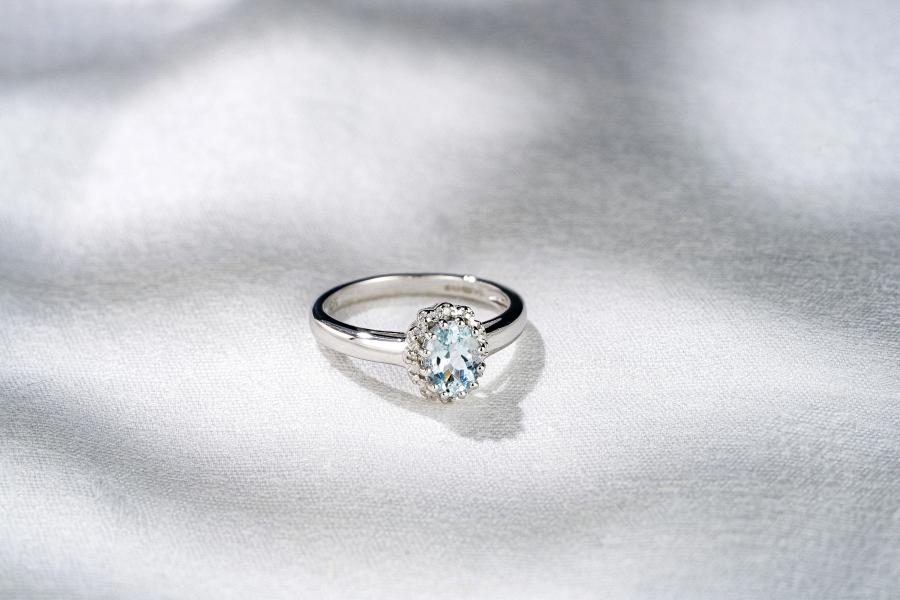Crystals have a rich history with its beauty and mystical beliefs, dating back thousands of years.
Crystals are incorporated into jewelry because of their unique structure, which contains atoms that are arranged in repeating patterns. This contributed to enhancing jewelry’s optical qualities, adding depth and brilliance.
In this guide, we will explore the common crystals/blings used in jewelry making, their meaning, and their impact.
Commonly Seen Crystal Types
Discussed below are the popularly seen crystals in jewelry pieces:
Rhinestone
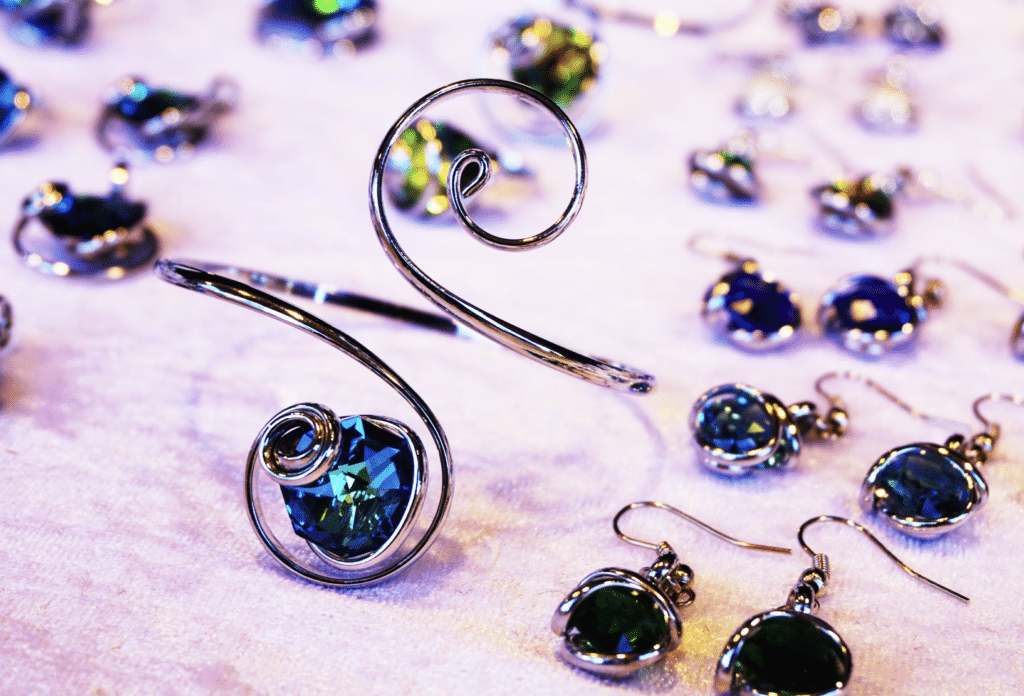
Rhinestones are synthetic, man-made crystals known for their sparkling, diamond-like appearance at a low price. Originally named after quartz stones, found along the Rhine River in Europe, rhinestones are crafted today from glass, acrylic, or crystal materials. After that, they are coated with a reflective backing to improve their sparkle. These crystals are available in several colors, shapes, and finishes.
While rhinestones don’t have traditional beliefs or healing properties like natural crystals, they are revered for their capacity to mimic the beauty of precious gemstones. Hence, they are commonly used in jewelries like earrings, bracelets, necklaces, brooches, and hair accessories.
Glass
Glass crystals are another widely used man-made option in jewelry because of their transparency and light reflection. Even though glass is a non-crystalline solid, it can be customized to look like a crystal. High-quality glass crystals undergo precise cutting techniques and polishing to increase their value.

Source: Pinterest
Glass in itself lacks the spiritual and healing powers associated with true crystals, but many people love its clarity and affordability. Glass crystals are often integrated in fashion jewelry like statement necklaces, pendants, rings, and chandelier earrings. They fit into intricate designs, as well as high-end and everyday jewelry.
Cubic Zirconia
Cubic zirconia (CZ) is the most common man-made crystal. It’s referred to as the substitute of diamonds because of its brilliance, clarity, and overall structure. However, CZ only costs a fraction of the diamond’s price. While it’s particularly created to mimic the hardness and sparkle of diamonds, cubic zirconia grades around 8-8.5 on the Mohs scale versus diamond that’s graded 10.

CZ is believed to hold metaphysical properties associated with luxury and status since it resembles diamonds. Some people also believe that CZ boosts the wearer’s confidence and sense of beauty. Cubic zirconia jewelry includes rings, earrings, pendants, and bracelets. They are often used in high-end fashion pieces, offering a luxurious look at an affordable price.
Nano Gem
Nano gems, otherwise known as nanocrystal or nano stones, are high-quality synthetic crystals developed using nanotechnology. These crystals can be seen in a wide range of colors, ranging from deep blues and greens to rich reds and yellows. They are highly valued for their durability, color stability, and serve as alternatives in scenarios where cubic zirconia is not feasible.

Source: Pinterest
They are highly revered for their color vibrancy and long-lasting brilliance. In the jewelry industry, they are valued for adding color and sparkle to pieces of jewelry while maintaining durability. Common applications of nano gems are seen in fine and custom jewelry pieces.
Synthetic Spinel
This is a man-made version of natural spinel, engineered to replicate its vibrant colors and optical properties. Synthetic spinel can be made in numerous colors, such as vivid pink, cobalt blue, and emerald green. Each of its colors offers slightly different reflective qualities. If you’re seeking a cheaper substitute when cubic zirconia is not available, you can count on this crystal.

Source: Pinterest
Unlike some man-made crystals, synthetic spinel maintains consistent color without fading throughout its lifetime. Its vibrant colors are believed to exude joy and showcase self-expression. Some people also associate it with revitalization and pure energy. Synthetic spinel is particularly favored in jewelry where bright colors are desired.
Synthetic Corundum
This is a lab-created version of natural corundum. It belongs to the ruby and sapphire mineral family, which are one of the hardest minerals (9 on the Mohs scale), below diamonds. This hardness makes synthetic corundum extremely strong and suitable for high-wear jewelry pieces.
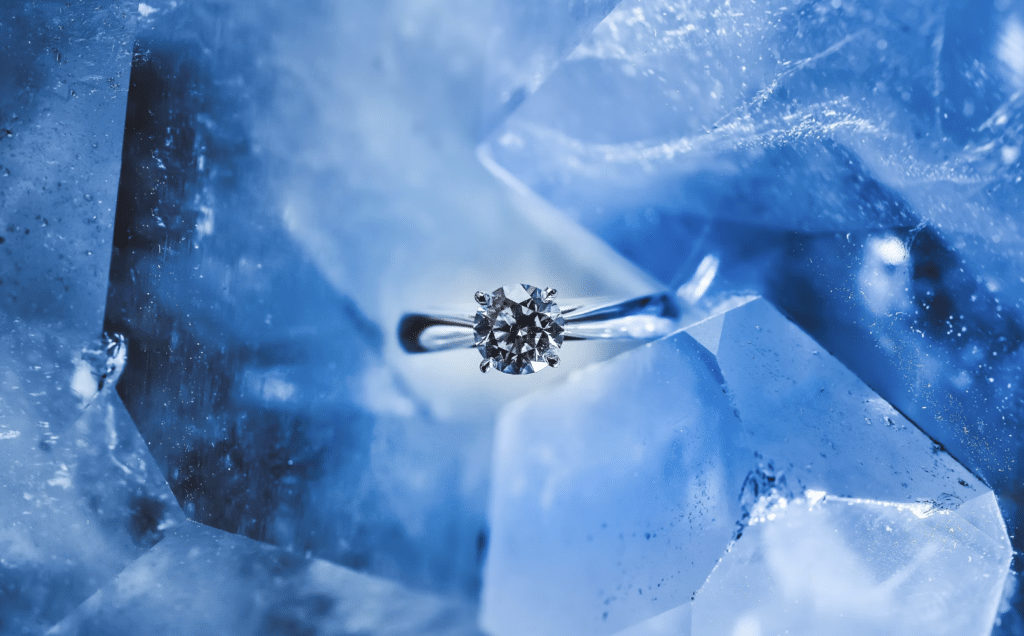
Synthetic corundum can be made in a variety of colors, such as deep blue (sapphire) and rich red (ruby), with each color’s atomic arrangement reflecting light in different ways based on its composition. Corundum is believed to offer strength, focus, and wisdom. But synthetically, it’s used in jewelry pieces that symbolizes resilience and endurance.
Moissanite
Moissanite, which was originally discovered in meteorites, is another crystal that shares close resemblance with diamonds. However, natural moissanite is rare, so most moissanite crystals in circulation now are lab-created.
This crystal can also be used as a substitute to cubic zirconia, especially in high-end jewelry because of its extreme durability and sparkle. Moissanite is the closest to diamonds, as it’s graded 9.25 on the Mohs hardness scale. Meanwhile, it has a very high refractive index, which makes it extremely brilliant, even more so than diamonds. This gives any jewelry it’s used for a fiery sparkle that is easily noticed.

Moissanite is often associated with luxury, brilliance, and resilience. Many people connect moissanite jewelry to a symbol of commitment and longevity, especially in engagement rings, earrings, and statement necklaces.
Natural Stones
Natural stones are minerals that are found in nature and are used in their raw state in jewelry. There are a wide range of these types of stones, such as malachite, amazonite, onyx, amethyst, turquoise, agate, quartz, topaz, etc. These stones have unique colors, patterns, and symbolic properties.

Natural stones are usually in 2 forms: completely natural occurring and half-synthetic.
- Naturally Occuring
Naturally occurring stones are derived from the earth and cut into desired shapes without any lab processing. These stones have different chemical structures and crystal patterns, which affects how they reflect light and appear in jewelry. For instance, while the quartz stone exudes a more subtle glow, the topaz stone shines more brightly.
Naturally occurring stones are largely linked with metaphysical properties and healing powers. For example, amethyst is believed to promote calmness, and rose quartz is associated with love & emotional healing. Each stone’s distinct color and symbolism makes them popularly used for personalized pieces, such as birthstone jewelry.
- Half-synthetic
Half-synthetic stones are made by compressing natural stone powder with colors, resins, or bonding agents. This process results in crystals that mimic the appearance of natural stones, but at a cheaper price and with smoother color & texture. These stones are frequently used when durability and affordability are priorities.
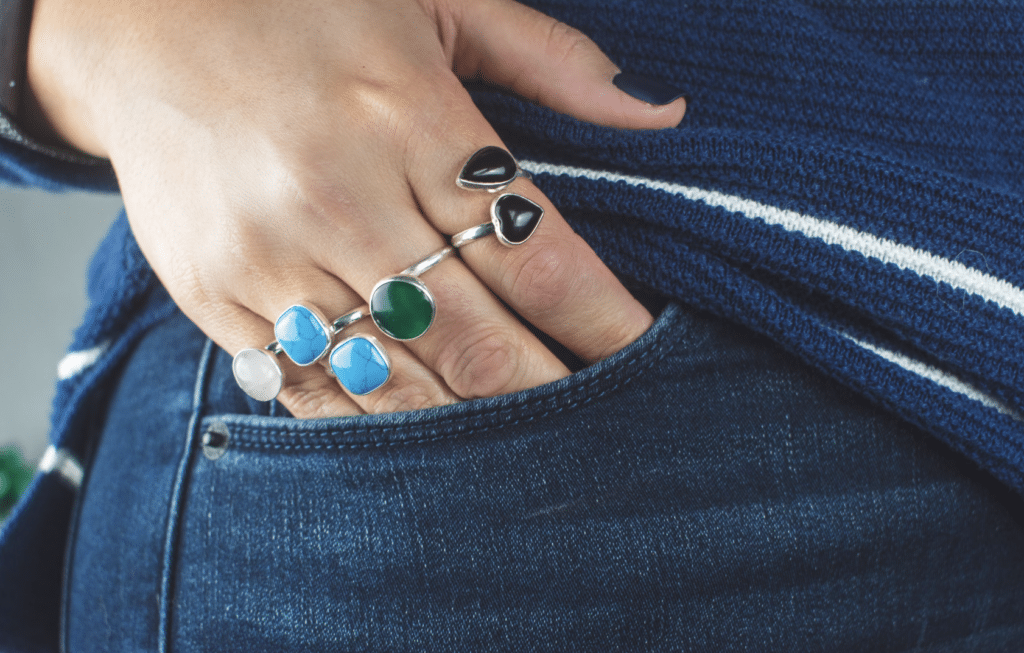
While half-synthetic stones are processed versions of natural stones, they still retain some properties of natural minerals. However, they reflect light differently, as they often show less variation.
Overall, half-synthetic stones are appreciated for their aesthetic and practical qualities. Hence, why they are commonly used in fashion jewelry and larger statement pieces like bracelets and pendants.
Lab-Grown Diamonds
These are diamonds created in controlled laboratory environments to replicate the natural processes of real diamond formation. They are engineered chemically, physically, and optically to be identical as naturally occurring diamonds.

Source: Pinterest
Lab-grown diamonds have the same hardness grade as natural diamonds (10 on the Mohs scale) and they share the same belief, representing love, commitment, and resilience. They are created in a variety of cuts, colors, and carat sizes, making them useful for both traditional and modern jewelry designs.
Lab-grown diamonds are more affordable, which makes them a preferred option to people seeking for real diamonds but at a cost-friendly price.
Naturally Occurring Diamonds and Natural Gemstones
Naturally occurring diamonds are real diamonds formed deep within the Earth’s mantle under intense pressure and heat for over thousands of years. These diamonds are the highest standard of beauty and luxury in the jewelry industry. They are greatly valued for their rarity, brilliance, and extreme hardness.
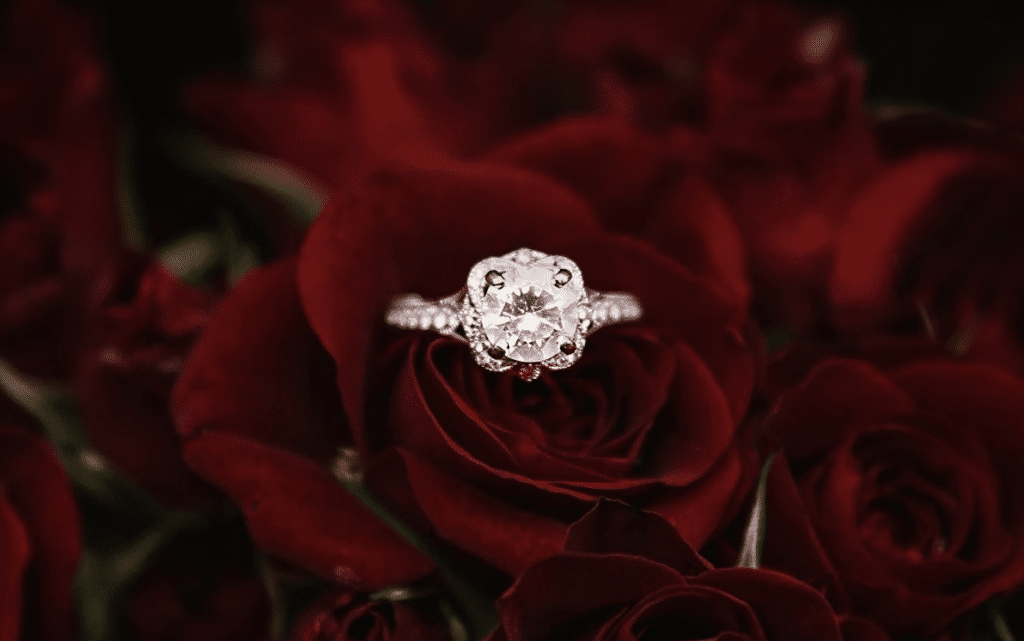
Naturally occurring diamonds are believed to be connected with strength, purity, and endurance, as well as a symbol of love and commitment. They are also associated with bringing clarity to the wearer and ensure focus.
Natural gemstones, just like naturally occurring diamonds, are organic minerals that are derived from the Earth and cherished for their color, rarity, and metaphysical properties. The major ones are sapphires, rubies, emeralds, amethysts, topaz, aquamarines, and opals.
Throughout history, natural gemstones have been used for their symbolic and healing properties. For example, sapphires are believed to exhibit wisdom, rubies exhibit passion, and emeralds exhibit growth and healing.
Recommended Crystal/Bling Choice Based On
When choosing crystal for jewelry, it’s advisable to consider factors like market positioning, price range, and experts’ guidance to ensure you make the right decision.
Jewelry Brand Market Positioning
The crystal you select should blend with your brand’s image and target audience. Aligning crystal choices with brand identity helps to promote your brand loyalty and appeal directly to your target audience.
For example, if you identify as a luxury brand, your market positioning will be centered on people who want premium pieces. The best crystal options to select for your brand are lab-grown diamonds, natural diamonds, and natural gemstones.
Brands focused on providing fashion or trendy pieces to younger, budget-conscious audiences, may use affordable crystals like rhinestones, cubic zirconia, nano gems, synthetic spinel, and synthetic corundum.
Price Range
Check the price range of the various types of crystals you’re considering and choose the one that doesn’t exceed your budget. Natural diamonds are the most expensive because of their exclusivity, unmatched brilliance, and durability. You can consider moissanite price, as well as lab-grown diamonds and natural gemstones if you’re looking for an averagely cost crystals.
For the lowest priced crystals, rhinestones, cubic zirconia, and synthetic spinel are ideal for mass production of fashion based pieces.
Consult Experts for Technical Advice
Consulting jewelry industry experts who can provide valuable insight into which option to choose. You will be guided on important factors like different crystal hardness, color, light reflection, and metaphysical properties, which determine their longevity and customers’ satisfaction.
Additionally, experts can offer technical advice to evaluate trends, ethical sourcing practices, and sustainability. Recommendations will also be made to align your brand with current industry standards and customers’ preferences.
Key Takeaway
Including crystals in jewelry is a long-time tradition that started majorly because of their metaphysical properties, healing power beliefs, and beauty. Nowadays, there are several types of crystals used in jewelry industry, which include rhinestones, glass, cubic zirconia, nano gem, synthetic spinel, synthetic corundum, moissanite, natural stones, lab-grown diamonds, natural diamonds, and natural gemstones.
Choosing which of these crystals is best for your brand depends on your market position, budget, and expert advice.

